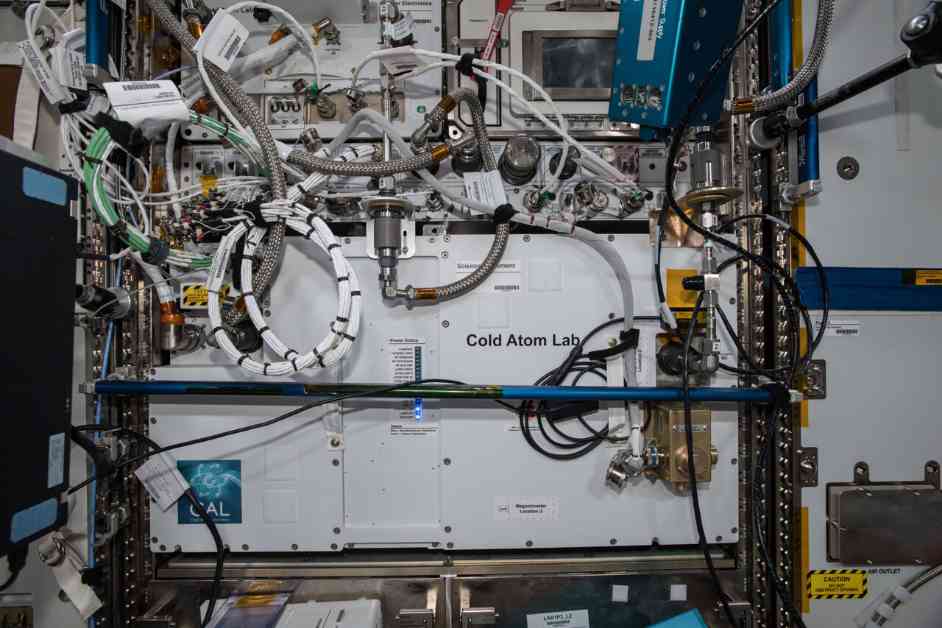NASA Successfully Deploys Quantum Sensor in Space Mission
NASA has achieved a groundbreaking milestone in quantum science by successfully deploying a quantum sensor in space through its Cold Atom Lab aboard the International Space Station. This cutting-edge facility has demonstrated the use of an atom interferometer, a quantum tool capable of measuring gravity and other forces with exceptional precision. The implications of this achievement are vast, with numerous potential applications in space exploration and beyond.
The Cold Atom Lab is a state-of-the-art facility that represents a significant leap forward in the utilization of quantum science in space. Recently, the science team operating the lab made history by employing ultra-cold atoms to detect subtle vibrations of the space station itself. This marks the first time that such precise measurements have been conducted in the space environment, showcasing the groundbreaking capabilities of the Cold Atom Lab.
The results of this groundbreaking study were published in Nature Communications on August 13, highlighting the exceptional advancements made in the field of quantum science in space. Notably, the study reports the longest demonstration of the wave-like nature of atoms in freefall in space, underscoring the incredible potential of this technology for future space missions.
Revolutionizing Space Science with Quantum Tools
The Cold Atom Lab’s use of an atom interferometer represents a significant step forward in the field of quantum science. This cutting-edge tool enables scientists to precisely measure gravity, magnetic fields, and other forces in ways that were previously unimaginable. By harnessing the power of quantum technology, researchers can delve into the fundamental nature of gravity and develop technologies that have far-reaching implications.
One of the key advantages of employing atom interferometry in space is the microgravity environment, which allows for longer measurement times and increased instrument sensitivity. While the delicate nature of this equipment has posed challenges in the past, the Cold Atom Lab has demonstrated that it is indeed possible to utilize such sensitive tools remotely from Earth, opening up new possibilities for space-based research.
Jason Williams, the Cold Atom Lab project scientist at NASA’s Jet Propulsion Laboratory, emphasized the dedication and adventurous spirit of the team in overcoming the challenges associated with this milestone achievement. The successful deployment of the atom interferometer in space represents a significant advancement in our understanding of quantum science and its applications in the realm of space exploration.
Potential Applications of High-Precision Gravity Measurements
The high-precision gravity measurements enabled by the atom interferometer have a wide range of potential applications in space science. For instance, these sensors could provide valuable insights into the composition of planets and moons in our solar system by detecting subtle variations in gravity caused by differences in material densities. This information could revolutionize our understanding of celestial bodies within our cosmic neighborhood.
The U.S.-German collaboration GRACE-FO is already utilizing gravity measurements to track the movement of water and ice on Earth, showcasing the practical applications of such technology. An atom interferometer could enhance the precision and stability of these measurements, offering a deeper understanding of surface mass changes and environmental dynamics on our planet.
Furthermore, precise gravity measurements could shed light on the mysteries of dark matter and dark energy, two enigmatic phenomena that continue to puzzle cosmologists. Dark matter, which constitutes a significant portion of the universe, remains invisible yet exerts a gravitational influence on celestial objects. Dark energy, on the other hand, drives the universe’s accelerating expansion, presenting a profound cosmic mystery that could be unraveled through advanced gravity measurements.
Advancing Quantum Technologies for Everyday Life
The deployment of the atom interferometer aboard the International Space Station represents a significant leap forward in quantum science research. This portable lab, roughly the size of a minifridge, has been instrumental in advancing quantum technologies by providing a long-term facility for studying ultra-cold atoms in the microgravity environment of low Earth orbit.
By cooling atoms to nearly absolute zero, the Cold Atom Lab enables the formation of Bose-Einstein condensates, a unique state of matter where atoms share the same quantum identity. This allows scientists to study the macroscopic quantum properties of atoms, providing valuable insights into their wave-like behavior and physical transitions.
In the microgravity environment of space, Bose-Einstein condensates can reach colder temperatures and exist for longer periods, offering scientists unprecedented opportunities to explore the quantum realm. The atom interferometer, along with other tools in the facility, leverages the quantum nature of atoms to enable precision measurements that could revolutionize our understanding of fundamental physical phenomena.
Nick Bigelow, a professor at the University of Rochester and Cold Atom Lab principal investigator, emphasized the transformative potential of space-based atom interferometry. By unlocking new discoveries and advancing quantum technologies, this groundbreaking research could pave the way for a quantum future that impacts everyday life in profound ways.
In conclusion, NASA’s successful deployment of a quantum sensor in space through the Cold Atom Lab represents a significant achievement in the field of quantum science. By harnessing the power of ultra-cold atoms and atom interferometry, researchers have opened up new frontiers in space exploration and fundamental physics. The implications of this milestone are far-reaching, with potential applications in planetary science, cosmology, and the development of cutting-edge quantum technologies that could reshape our understanding of the universe.













